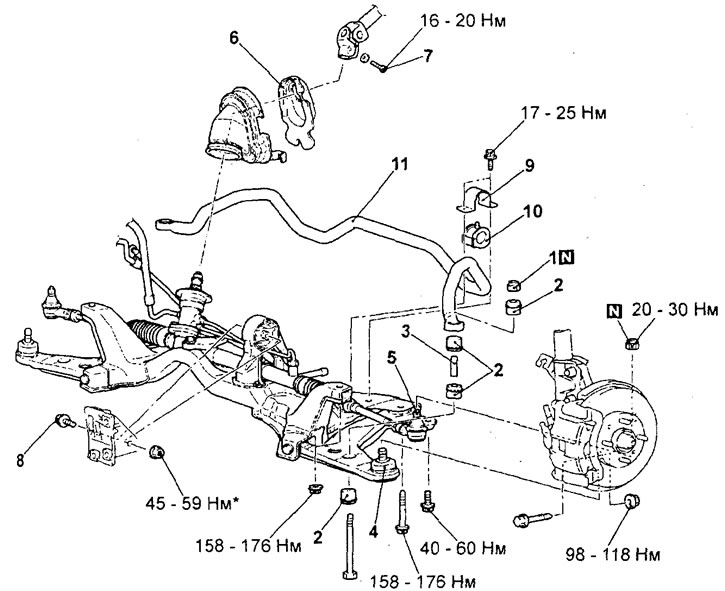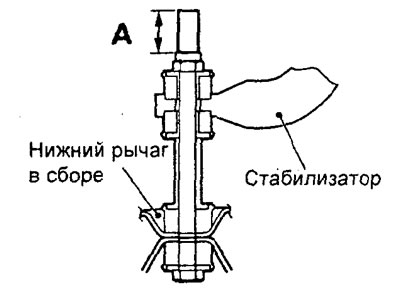Attention: on models with an additional passive safety system (SRS) before removing the steering gear, set the front wheels to the straight-ahead position and remove the key from the ignition. Failure to comply with these conditions may result in damage to the SRS coiled wire and unauthorized deployment of the airbag, which in turn will result in serious injury.
Removing
− Perform the following operations before removing parts.
A) Remove the lower protective casings of the power unit.
b) Remove steering wheel and driver airbag module (see chapter "Steering"),
V) Remove the SRS coiled wire (see chapter "SRS passive safety system").
G) Remove the central longitudinal beam (see chapter "Power unit supports").
d) Remove the exhaust pipe (see chapter "Intake and exhaust systems").
− Removal of parts is carried out in the order of numbers indicated in the figure "Removing the stabilizer bar".

Removing the stabilizer bar. 1 - locknut, 2 - rubber bushing of the stabilizer link, 3 - bushing, 4 - ball joint of the lower arm, 5 - ball joint of the tie rod end, 6 - steering column cover, 7 - steering shaft bolt, 8 - connecting bolt of the rear support of the power unit, 9 - stabilizer mounting bracket, 10 - bushing, 11 - anti-roll bar.
− Pay attention to the following operations when removing parts.
1. Disconnecting the lower arm of the front suspension from the steering knuckle.
Using the special tool, disconnect the lower control arm from the steering knuckle.
Attention:
- To prevent the puller from jumping off, you must first tie it with a cord.
- Just loosen the nut on the ball joint pin, do not unscrew the nut completely.

Attention: it is only necessary to pre-tighten the nut marked with the sign and make the final tightening on an unloaded vehicle after lowering it onto the wheels.
2. Removing the stabilizer mounting bracket, bushing, stabilizer bar and anti-roll bar.
Note: Follow the steps below before removing the stabilizer mounting bracket, bushing, stabilizer link and anti-roll bar.
A) Move the transmission telescopic strut under the cross beam, remove the bolts and nuts securing the cross beam.

b) Lower the cross member until the retainers, bushings, stabilizer links and anti-roll bar can be removed.
Attention: do not lower the cross beam too low, so as not to deform the bracket for attaching the return hose of the power steering hydraulic system.
Examination
1. Check bushings for wear, damage and deterioration.
2. Check the anti-roll bar for damage or wear.
3. Check the condition of all bolts.
4. Check up a condition of a protective cover of a spherical hinge.
Attention:
- - Cracks and damage to the protective boot can damage the ball joint.
- - If the protective cover is damaged during maintenance work, replace the protective cover with a new one and repeat the check.
Installation
− Installation of parts is carried out in the reverse order of removal. Pay attention to the following operations when installing parts.
1. Installation of the anti-roll bar, bushing and anti-roll bar mounting bracket.
Position the bracket so that the distance between the edge of the bushing and the edge of the alignment mark of the stabilizer on the side of the longitudinal axis of the vehicle is approximately 10 mm.

2. Installing the locknut.
Tighten the self-locking nut until the length "A" the protruding part of the stabilizer link will not reach the nominal value.
Nominal value - 20.5 - 23.5 mm

− After completing the installation of the parts, perform the following operations.
A) Install the exhaust pipe (see chapter "Intake and exhaust systems").
b) Install the center stringer (see chapter "Power unit supports").
V) Install SRS Coiled Wire (see chapter "SRS passive safety system").
G) Install steering wheel and driver airbag module (see chapter "Steering"),
d) Check protective covers for mechanical damage,
e) Check the middle position of the steering wheel when the front wheels are parallel to the longitudinal axis of the vehicle.
and) Checking and adjusting the angles of the front wheels.
h) Install the power unit lower guards.
